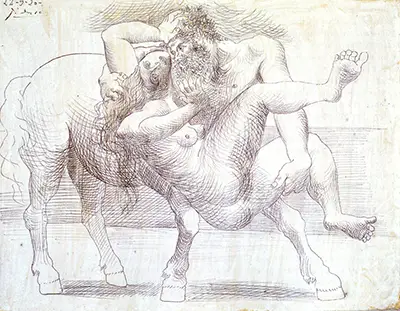She gets this poisoned tunic from Nessus, a wild centaur who abducts her and attempts to sexually assault her but promises her that his clothing will make her husband stay faithful to her if she gives it to him after Nessus is dead. This piece depicts the part of the story in which the kidnapping occurs. The image itself is striking in its peculiarity. Nessus is far more conventionally drawn in comparison to his captive; his only slightly strange feature is his exaggerated largeness, a choice which makes him look more menacing in his role as captor. This suggests that Deianeira's distorted appearance is meant to represent her fear and distress in this threatening situation.
Her head and neck are contorted to a frightening degree, but they place her head in direct opposition to Nessus' leering gaze. She is fighting as hard as she can to be free, even if her efforts are not getting her the results she wants. Her head's noticeable separation from her body communicates the mortal peril she is in on top of her emotional pain, as well - even if Nessus' goal is not to kill, he is a powerful mythical creature and she may easily not survive. The sexual nature of this threat is clarified by the emphasis on her hips, thighs and rear and the way in which her torso twists unnaturally to expose her breasts to the viewer.
Deianeira's vulnerability is clear, and the intense exposure she faces parallels her own helplessness to stop the impending assault from happening; even if she were able to cover herself with an arm or position herself strategically to hide, it wouldn't make any difference to the end result. Instead, resistance is more important to her than modesty. The piece forces the viewer to grapple with the violence inherent to sexual assault while using mythological foundations to keep the image distanced enough from real crimes to remain respectful. It is uncomfortable to look at, but that is part of what makes it an excellent piece of art.

